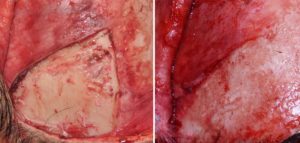Temporal reduction is an effective method for narrowing the wide head. The wide head is defined as the area above the ears that has too much convexity or fullness. Extreme fullness at the sides of the head occurs when the width of the head gets near a vertical line drawn up superiorly from the inside of the superior helix of the ear. But many affected patients may feel they have too much convexity even when its width is well inside the profile of the ear.
While many feel that temporal bone reduction is the key to head width reduction, it actually is not. The thickness of the posterior temporal muscle is what constitutes a significant part of the side of the head. Its removal makes an immediate and visible reduction in its convexity, changing it to a completely or near complete flat profile. Surprisingly the removal of the posterior temporal muscle has no functional impairment on lower jaw motion or function.
In the technique of temporal reduction by myectomy, which is usually performed through a postauricular incision, a vertical cut through the temporal muscle is made from the attachment of the ear superiorly to the temporal line at the top of the skull. All muscle behind this line is removed leaving the overlying fascia in place. With muscle thicknesses averaging 7 to 9mms in thickness this leaves a very palpable and sometimes visible step-off in the temporal contour. The posterior cut edge of the large remaining anterior temporal muscle is cauterized for both hemostasis and in the belief that muscle atrophy will eventually smoothest the shape of the cut edge of the muscle.

Dr. Barry Eppley
Indianapolis, Indiana


